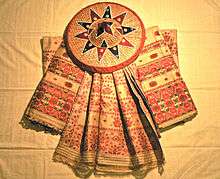Muga silk
| Muga silk | |
|---|---|
| Geographical indication | |
 Muga silk mekhala and chador with jaapi | |
| Type | Handicraft |
| Area | Assam |
| Country | India |
| Registered | 2007 |
| Material | Silk |
Muga silk is a variety of wild silk geographically tagged[1] to the state of Assam in India. The silk is known for its extreme durability and has a natural yellowish-golden tint[2] with a shimmering, glossy texture.[3] It was previously reserved for the use of royalty.[4]
In the Brahmaputra Valley, the larvae of the Assam silkmoth feed on aromatic som (Machilus bombycina) and sualu (Litsaea polyantha) leaves. Muga silk can be dyed after bleaching. This silk can be hand-washed with its lustre increasing after every wash.[5] Muga silk, like other Assam silks, is used in products like saris, mekhalas and chadors.[2]
History
Sericulture in Assam is an ancient industry without a precise time of origin. Muga production received great patronage from the Ahom dynasty (1228–1826), under whose reign muga culture thrived and became a part of the social and economic life of the Assamese people. Royalty and senior mandarins were prescribed clothing made of the silk. Ahom kings were known to keep many costly muga sets in the royal storehouse for presentation to distinguished visitors to their court. Queens were personally involved in training weavers. The fabric was also a chief export of the Ahoms.[6]
Muga silk was recognized as a protected geographical indication (GI) in 2007, and was granted a GI logo for trademark purposes in 2014. The logo has been registered with the Assam Science Technology and Environment Council. The Central Silk Board of India has been granted the authority to inspect muga silk products, certify their authenticity and allow producers to use the GI logo.[7] This board is also involved in R&D and infrastructure development for Assamese silk, including muga, through the Central Muga Eri Research & Training Institute (CMER&TI) in Jorhat, Assam.[5]
India produced 158 tonnes of muga silk in FY 2014–15, out of which 136 tonnes were produced in Assam. India's total silk output in the same period amounted to 28,708 tonnes.[8]
References
- ↑ "GI Registry India". Statewise Registration Details of GI Applications. Intellectual property India. Retrieved 27 January 2016.
- 1 2 "Muga Silk". Central Silk Board, Ministry of Textiles, Government of India. 3 July 2014. Retrieved 27 January 2016.
- ↑ Hyde, Nina (1984). "The Queen of Textiles". National Geographic. 165 (1): 14.
- ↑ "Non-wood products from organisms associated with temperate broad-leaved trees". Food and Agriculture Organization. Retrieved 27 January 2016.
- 1 2 "CMER&TI". CMER&TI. Retrieved 31 January 2016.
- ↑ Phukan, Raju (2012). "Muga Silk Industry of Assam in Historical Perspectives" (PDF). Global Journal of Human-Social Science. 12 (9): 5–8.
- ↑ "Finally, muga gets GI logo". The Telegraph, Calcutta. 28 April 2014. Retrieved 29 January 2016.
- ↑ "CSB Annual Report 14-15" (PDF). Annual Report 2014–15. Central Silk Board, India. November 2015. pp. 5, 123. Retrieved 29 January 2016.